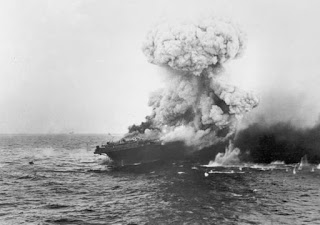4th May 1942 marked the start of the Battle of the Coral Sea, between the Imperial Japanese Navy and U.S.
4th May 1942 marked the start of the Battle of the Coral Sea, between the Imperial Japanese Navy and U.S. and Australian naval forces, in the first-ever naval action in which the opposing fleets neither sighted nor fired upon one another, attacking over the horizon with aircraft carriers instead.
By early 1942, the Japanese had made rapid gains in South East Asia. By April, they were also ready to seize control of the Coral Sea, off the northeast coast of Australia, by establishing air bases at Port Moresby, in Papua New Guinea, and at Tulagi, in the Solomon Islands. This would enable them to strengthen their defensive perimeter and to sever lines of communication between Australia and the United States.
Accordingly, an invasion force was assembled, while the aircraft carriers Shōkaku and Zuikaku were dispatched to the Coral Sea to provide air cover and to intercept and destroy any Allied naval forces that entered the area. U.S. intelligence intercepted Japanese communications, and as a result, two U.S. Navy carrier task forces and a joint Australian-American cruiser force were sent to oppose the offensive.
On 3rd May, Japanese forces occupied Tulagi, but several supporting warships were sunk or damaged in a surprise attack by aircraft flown from the U.S. carrier Yorktown on the following day. While the Japanese now attempted to locate the U.S. carriers, the Americans were also trying to locate the two Japanese carriers. On 7th May, both fleets launched airstrikes against what they thought were the enemy carriers. Instead, the Americans sank the light carrier Shōhō, while the Japanese sank a destroyer and damaged a fleet oiler. Both sides finally located and attacked each other's carriers on 8th May. Shōkaku was badly damaged, as were Yorktown and Lexington, the latter eventually being scuttled. Having also suffered heavy aircraft losses, both sides withdrew from the area.
Although the battle was a tactical victory for the Japanese in terms of ships sunk, it was a strategic victory for the Allies. The battle was the first time since the start of the war that a major Japanese advance had been turned back, while it also averted the seaborne invasion of Port Moresby. More importantly, the damage to Shōkaku and the aircraft losses of Zuikaku prevented both ships from participating in the Battle of Midway the following month.











Comments
Post a Comment